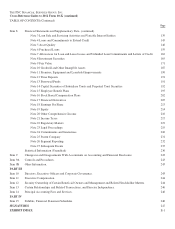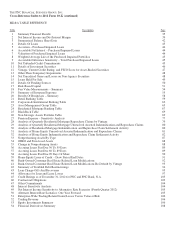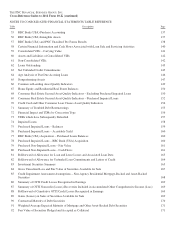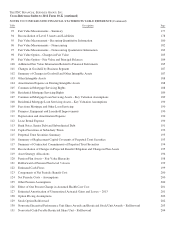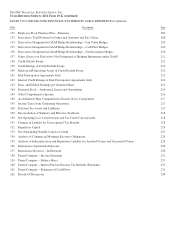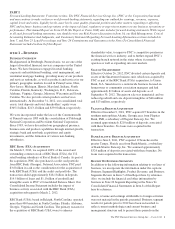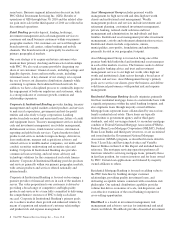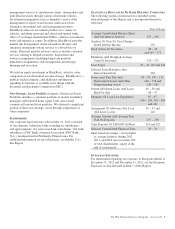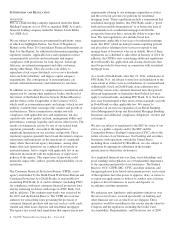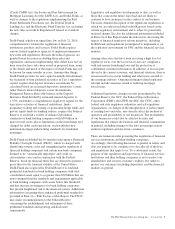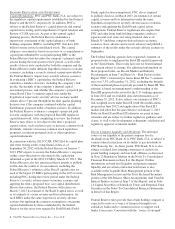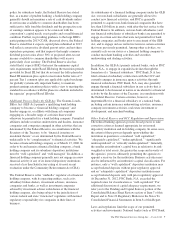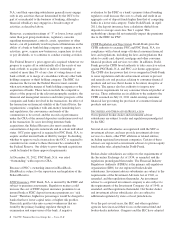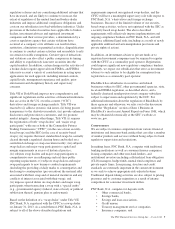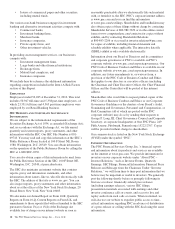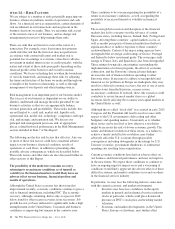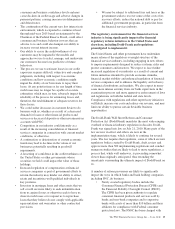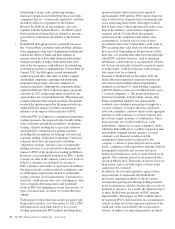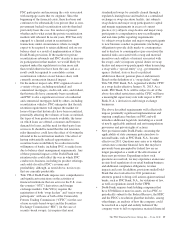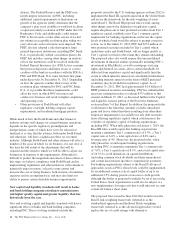PNC Bank 2012 Annual Report Download - page 25
Download and view the complete annual report
Please find page 25 of the 2012 PNC Bank annual report below. You can navigate through the pages in the report by either clicking on the pages listed below, or by using the keyword search tool below to find specific information within the annual report.
B
ANKING
R
EGULATION AND
S
UPERVISION
Capital Regulations. PNC and PNC Bank, N.A. are subject to
the regulatory capital requirements established by the Federal
Reserve and the OCC, respectively. In addition, PNC is
subject to the Federal Reserve’s capital plan rule and annual
capital stress testing and Comprehensive Capital Analysis and
Review (CCAR) process. As part of this annual capital
planning process, the Federal Reserve undertakes a
supervisory assessment of the capital adequacy of bank
holding companies (BHCs), including PNC, that have $50
billion or more in total consolidated assets. This capital
adequacy assessment is based on a review of a comprehensive
capital plan submitted by each participating BHC to the
Federal Reserve that describes the company’s planned capital
actions during the nine quarter review period, as well as the
results of stress tests conducted by both the company and the
Federal Reserve under different hypothetical macro-economic
scenarios, including a severely stressed scenario provided by
the Federal Reserve (supervisory severely adverse scenario).
In evaluating a BHC’s capital plan, the Federal Reserve
considers a number of factors, including the company’s risk
profile, the strength of the company’s internal capital
assessment process, and whether the company’s projected pro
forma Basel I Tier 1 common capital ratio under the
hypothetical supervisory severely adverse scenario would
remain above 5 percent throughout the nine quarter planning
horizon even if the company continued with the capital
distributions proposed under a baseline scenario. In addition,
the Federal Reserve evaluates a company’s projected path
towards compliance with the proposed Basel III regulatory
capital framework. After completing its review, the Federal
Reserve may object or not object to the firm’s proposed
capital actions, such as plans to pay or increase common stock
dividends, reinstate or increase common stock repurchase
programs, or redeem preferred stock or other regulatory
capital instruments.
In connection with the 2013 CCAR, PNC filed its capital plan
and stress testing results using financial data as of
September 30, 2012 with the Federal Reserve on January 7,
2013. PNC expects to receive the Federal Reserve’s response
(either a non-objection or objection) to the capital plan
submitted as part of the 2013 CCAR by March 15, 2013. The
Federal Reserve also has announced that it intends to publish
on this date the results of its assessments, including the
Federal Reserve’s estimates of the Basel I capital ratios for
each of the largest 19 BHCs participating in the 2013 reviews,
including PNC, during the review period under the Federal
Reserve’s severely adverse macro-economic scenario and
applying the firm’s proposed base case capital distributions.
Prior to this release, the Federal Reserve will release on
March 7, 2013 its estimate of the Basel I capital ratios, as well
as its estimate of certain revenue and loss information, for
such BHCs under the same supervisory severely adverse
scenario but applying the common assumptions concerning
capital distributions by firms established by the Federal
Reserve for the stress tests required by Dodd-Frank (Dodd-
Frank capital action assumptions). PNC also is required
to publicly disclose, in March 2013, its estimates of certain
capital, revenue and loss information under the same
hypothetical supervisory severely adverse macro-economic
scenario and applying the Dodd-Frank capital action
assumptions. Federal Reserve regulations also require that
PNC and other large bank holding companies conduct a
separate mid-year stress test using financial data as of
March 31st and three company-derived macro-economic
scenarios (base, adverse and severely adverse) and publish a
summary of the results under the severely adverse scenario in
September.
The Federal banking agencies have requested comment on
proposed rules to implement the Basel III capital framework
in the United States. These rules have not yet been finalized
and remain subject to change. For additional information on
these proposed rules, see Recent Market and Industry
Developments in Item 7 and Item 1A – Risk Factors in this
Report. PNC’s estimated pro forma Basel III Tier 1 common
ratio was 7.5% at December 31, 2012, excluding the benefits
of the transitional phase-in periods provided by Basel III. This
estimate is based on management’s understanding of the
Basel III proposed rules issued by the U.S. banking agencies
in June 2012 and on available data and information as of
December 31, 2012. It also reflects our estimates of PNC’s
risk-weighted assets under Basel II (with the modifications
proposed in June 2012) and application of the Basel II.5
market risk rules that became effective on January 1, 2013.
Both our Basel II and Basel III estimates are point in time
estimates and are subject to further regulatory guidance and
clarity, as well as the development, refinement, validation and
regulatory approval of internal models.
Parent Company Liquidity and Dividends. The principal
source of our liquidity at the parent company level is
dividends from PNC Bank, N.A. PNC Bank, N.A. is subject to
various federal restrictions on its ability to pay dividends to
PNC Bancorp, Inc., its direct parent. PNC Bank, N.A. is also
subject to federal laws limiting extensions of credit to its
parent holding company and non-bank affiliates as discussed
in Note 22 Regulatory Matters in the Notes To Consolidated
Financial Statements in Item 8 of this Report. Further
information on bank level liquidity and parent company
liquidity and on certain contractual restrictions is also
available in the Liquidity Risk Management portion of the
Risk Management section and the Trust Preferred Securities
portion of the Off-Balance Sheet Arrangements And Variable
Interest Entities section of Item 7 of this Report, and in Note
14 Capital Securities of Subsidiary Trusts and Perpetual Trust
Securities in the Notes To Consolidated Financial Statements
in Item 8 of this Report.
Federal Reserve rules provide that a bank holding company is
expected to serve as a source of financial strength to its
subsidiary banks and to commit resources to support such
banks if necessary. Consistent with the “source of strength”
6The PNC Financial Services Group, Inc. – Form 10-K


